Much of what we know about patterns of biodiversity has come from extensive fieldwork, with expert researchers sampling and identifying species in a process that takes thousands of man-hours. But new technologies may revolutionize this process, allowing us to monitor changes in biodiversity at speeds and scales unimaginable just a decade ago.
A new paper published in Ecology Letters offers one technological solution to the problem of monitoring biodiversity in real time – Metabarcoding. This method can provide rapid biodiversity estimates from a mashed-up cocktail of specimens nicknamed “insect soup.” It works by simply blending all the samples, then using DNA technology to pick out known species.

“Each soup combines hundreds to thousands of insects caught using insect traps, but this poses no threat to endangered species because the numbers captured still amount to only a tiny fraction of their overall populations. We can then extract the DNA of all those insects from the ‘soup,'” said Roger Kitching of Griffith University, Australia. “Even small fragments of that DNA can be used to identify species,” he said. “Each soup combines hundreds to thousands of insects caught using insect traps… we can then extract the DNA of all those insects from the ‘soup.’”
To see how effective the method was, they compared their results with those of conventional studies, finding similar levels of accuracy with vastly smaller survey effort.
“We compared our results with high-quality datasets collected in Malaysia, China and the UK which combined more than 55,000 arthropod and bird specimens and took experts 2,505 hours to identify,” Kitching said. “We found that our ‘soup’ samples give us the same biodiversity information as those gold-standard datasets.”
Many of the proposed conservation initiatives such as REDD+ or biodiversity offsetting, whereby payments can be made in return for maintaining biodiversity, rely on measuring and monitoring rapid changes in biodiversity. The authors hope this technology can one day be used in conservation management in conjunction with other new emerging technologies such as satellite technologies and drones.

“The combination of insect soup and satellites might let us infer some general biodiversity information from those images, “said Douglas Yu, one of the authors of the study. “Drones provide photos, and as long as it’s possible to have a chain of evidence to authenticate the location, time, and assigned taxonomy for evidence to authenticate the location, time, and assigned taxonomy for a photo, it becomes feasible to make management decisions (such as authorizing or stopping a payment). The same thing can be done for a metabarcode sample, as long as you also have a chain of evidence.”
Such technology means that monitoring changes in biodiversity can be done quickly, accurately and cheaply. “If the environment changes for the better or for the worse, we will know about it because the mix of DNA present in the ‘insect soup’ will also change,” Kitching said. “Thereby we have a rapid, sensitive and inexpensive warning system if the state of nature in that place changes.’
One of the advantages of using insect soup or other metabarcoding technology is that it reduces dependence on ‘indicator species’ – species that are easy to measure and are thought to represent the state of numerous other species. One of the dangers of indicator species is the temptation to over-rely in them.
“If we use indicators to judge the success or failure of a policy or payment scheme, the temptation is to teach to the test, to manage for the indicator itself, and not for what the indicator is meant to be representing, “ said Yu.
In contrast, by using insect soups or similar methods, researchers can quickly identify the general state of a region’s biodiversity as well as make conclusions about the ecological function of an ecosystem.

“A shortcut way of thinking about the simplest form of metabarcoding is that it is like a barebones GPS. A GPS can tell you very quickly your position in space but to put that position into context, you also want a map. With metabarcoding, that map is the science of ecology. So if metabarcoding tells you that you have 634 insecta taxa on a farm and that 93 of those species are in taxa known to pollinate, ecology can take that information and judge whether this is a good or bad sign.” Said Yu.
“This means that we can incorporate biodiversity into our decision-making within the same timescales as with other management issues, and it becomes possible to audit samples, which is crucial if, say, environmental certification or payment is made contingent on maintaining a minimum state of nature,” said Yu.
Despite the success of the study, the study notes that work still needs to be done to broaden the DNA reference databases.
“For insects, and arthropods generally, we use primers that amplify broadly, and we know that the primers that we use are pretty good, returning something above 80% of the arthropods that are in the samples,” said Yu. “But we also know that some higher-level taxa don’t amplify (or sequence) well, such as Hymenoptera [Wasps]. Thus, we are slowly moving to PCR-free methods, which sequence all the DNA [which] give us much less bias for or against particular lineages, which means that we should see more accurate biomass frequencies per species.”
To some extent the success of metabarcoding will depend on existing DNA data bases being expanded so that species can be identified at a higher resolution.
“Barcode reference databases are getting bigger, next-generation sequence lengths and qualities are increasing, and taxonomic-assignment software is getting more accurate, so I think that taxonomic assignment generally will become quite reliable soon, including the identification of species that are not yet in the database.”
Citations:
- Ji, Y., Ashton, L., Pedley, S. M., Edwards, D. P., Tang, Y., Nakamura, A., … Yu, D. W. (2013). Reliable, verifiable and efficient monitoring of biodiversity via metabarcoding. Ecology letters, 16, 1245–1257. doi:10.1111/ele.12162
This article was written by Dominic Rowland for Mongabay.com







Leave a Reply